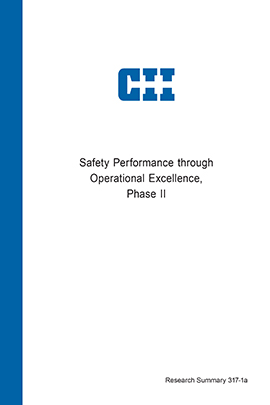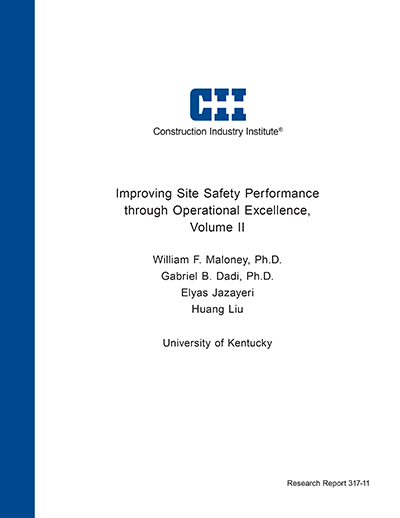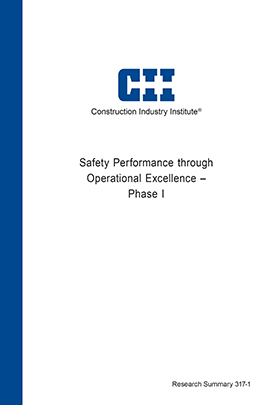
Safety Performance through Operational Excellence, Phase II
Upon completing its four-year journey to understand and model Operational Excellence (OE) for safety in the delivery of capital projects, Research Team 317 (RT-317) has concluded that OE is simply “doing the right thing, the right way, every time – even when no one is watching.” Developing a model to represent that concept during Phase I of the research led to outlining a holistic, professional, and rigorous safety program during Phase II. (Phase I is described in Research Summary 317-1 Safety Performance through Operational Excellence – Phase I, and Research Report 317-11, Improving Site Safety Performance through Operational Excellence.)
CII companies have found it challenging to reach the next level of safety performance. Some member organizations have spent significant resources developing programs and audits to improve safety. RT-317’s research products assist this effort by offering a proven model and an approach to conduct a large-scale assessment of a project’s commitment to safety. Users of the RT-317 findings will be able to identify gaps between what is stated at the corporate level and what is actually done in the field, identify areas that could yield the greatest opportunities for safety improvement up, down, and across their organizations, and ascertain the level of effort required for change.
RT-317’s research approach for Phase II, outlined in this research summary, involved weighting components of the OE model, operationalizing the model’s contents, creating an OE score, and collecting data against the model. The final data collection effort resulted in 77 responses across 25 projects. The average OE score for these projects was 42.9 out of a possible 66 points, corresponding to 65%. There is significant room for improvement for even the highest performing project (51.9, or 78%).
The RT-317 data collection effort generally shows that the higher the OE score achieved, the lower the safety incident rate (TRIR). Further, most projects saw a strong decline in awareness and implementation of safety programs from the corporate level to the site level. In other words, people at the corporate level believe a certain program is in place and functioning; however, the craft professionals are either not aware of the program or do not believe it is well implemented on site.
Ultimately, the products from RT-317 gave CII member companies an opportunity to see whether they (and their employees from corporate down to the site) “do the right thing, the right way, every time – even when no one is watching.”
Developing and/or refining a holistic safety management system is a daunting task. By drawing on a prioritization exercise, RT-317 made this task more manageable. The results of an Analytic Hierarchy Process (AHP) indicate which areas of a safety program can have the most immediate impact. This is not to say that items at the bottom of the table are unimportant but, rather, that the areas at the top should receive the first investigation.



